Warehouse pests
Home /
Warehouse pests
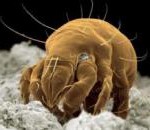
Flour mite (Tyroglyphus farinae)
Female flour mites are about 0.6 mm long, males 0.32–0.43 mm long. Males have suckers around the mouth opening. The flour mite lays eggs on grain, tree seeds, animal feed and dried fruit. Mites reproduce very quickly in moist feedstuffs. The humidity suitable for development is 75–85% and the optimal temperature is 18–22 °C.
The flour mite chews through the grain husk (from the seed leaf end) and remains in the grain. The entrance opening is not visible even when viewed through a magnifying glass. Hollows are chewed into the seeds, which become sticky and covered with a dust-like layer. Contaminated products are unsuitable for consumption – they have a musty smell, bitter taste and a dirty grey colour. They cause diarrhoea and allergies when consumed. The contaminated product must be destroyed as it contains toxins.
Avoidance: keep the grain and products made from it as dry as possible.
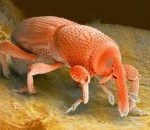
Wheat weevil (Calandra granaria)
It is a common grain pest. It is an insect of about 4 mm long, light brown (juveniles) to dark brown (adults) in colour with a long proboscis. It eats holes of different sizes into the grain. The grain is also damaged by the weevil larva. The larva is a 3–4 mm long curve-shaped caterpillar, white in colour, with a reddish head. The larva eats the grains from the inside, leaving behind the husks. With its activity, it promotes development of mites, and as a result, the grains heat up.

Yellow mealworm beetle (Tenebrio molitor)
It is up to a 15 mm long beetle, dark brown as an adult, black as a juvenile. Larvae are up to 30 mm long light-yellow maggots with a dark head. The beetle is nocturnal and is attracted to a musty smell, so discovering the yellow mealworm beetle indicates poor quality of the feed.
The grain is damaged by both the imago and the larva. A female lays up to 500 eggs. The larval stage is very long, 280–600 days. The maggots tolerate low temperatures well (live for several months at -5 °C). They produce one generation in two years.
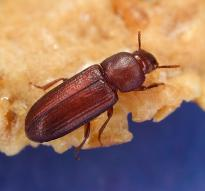
Destructive flour beetle (Tribolium destructor)
The beetles are about 5 mm long, blackish brown in colour. They lay eggs in products, seeds, cracks in the floor and wood. The maggots feed on both seeds and dry matter. They tolerate low temperatures (e.g. -6 °C for up to three weeks). We encounter them occasionally.

Confused flour beetle (Tribolium confusum)
A 3–3.5 mm long, reddish-brown, flightless beetle. They develop continuously in warm storage rooms. A female lays up to 1,000 eggs. Damage is caused by both the imago and the larva. Damaged grain becomes bitter and smelly due to the secretions of the pest.
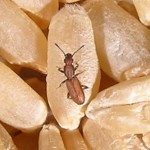
Sawtoothed grain beetle (Oryzaephilus surinamensis)
The imago is a 2.5–3.5 mm long dark brown beetle. It has spike-like appendages on the edges of the dorsal shield. Larvae are 3 mm long, yellowish with dark spots. Eggs are laid in clusters on cereal crops. A female can lay 600 eggs. In a cold room, the beetles winter over, in a heated room they develop all year round. They are unable withstand temperatures below 0 °C – they die. Besides cereals, they also damage dried fruits and vegetables, paper, wood, etc.

White marked spider beetle (Ptinus fur)
It is a small, 2–4 mm long brown beetle. Sexual dimorphism occurs. Maggots are up to 5 mm long, with a brown head, covered with fine hairs. Beetles are both herbivorous and predatory, both stages of development cause damage. With a nocturnal lifestyle, they lay eggs on cereal products, but also on cloth and skin. They tolerate low temperatures well (e.g. larvae can withstand -5 °C for 164 days). However, -15 °C has a fatal effect after a few days.

Golden spider beetle (Niptus hololeucus)
It is 3.5–4.5 mm long, brown in colour, with a curved back, covered with dense yellow hairs. The larva is 5–6 mm long, white, with a brown head, covered with fine hairs.
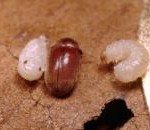
Drugstore beetle (Stegobium paniceum)
The imago is a 2–4 mm long light brown beetle. Larvae are 5–6 mm long dirty-yellow maggots. Four to five generations per year develop in a heated room. A female lays up to 140 eggs on foodstuff. Maggots chew grains, cereal products, dried fruit, leather, chocolate, book bindings, cardboard, paper, etc.
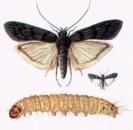
Mediterranean flour moth (Ephestia kuehniella)
The Mediterranean flour moth is a 1 cm long butterfly, the forewings have black stripes and spots, the hindwings are lighter with a dark border. The butterfly lays up to 500 eggs on the walls of repositories and containers. The larvae are 2 cm long, initially red in colour, later completely white, only the head and the back of the body remain red; they live in a tube of cobweb. The larva secretes a sticky thread, contact with which causes feed to stick in clumps. Three to four generations per year.
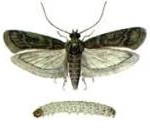
Cacao moth (Ephestia elutella)
The butterfly’s forewing is up to 9 mm long, narrow with obscure dark cross stripes, the hindwing is light brown. Lays eggs on tobacco, nuts, grain, seeds, etc. Damage is caused by the larva, which feeds in a cobweb. Temperatures below -3 °C are quickly fatal.
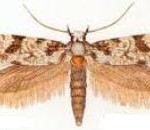
European grain moth (Tinea Granella)
The imagoes are 9–14 mm long, with silver-grey forewings and narrow hindwings, long lashes. The larva is 1 cm long, yellowish white in colour, with a light brown head, and it secretes a sticky liquid. It pupates in a cocoon in shady places. Mainly damages rye and wheat grains. The damage is characterised by the appearance of sticky and emptied-out grains in clumps. As a result of the damage, a crust forms on the surface of the grain.
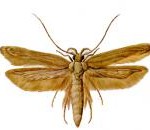
Angoumois grain moth (Sitotroga cerealella)
The forewings of the butterfly are greyish yellow, the hindwings are grey with long lashes, the wingspan is 13–14 mm. Caterpillars are 7–8 mm long. The larva damages one grain, at one end of which it pupates. Arrives in the repository with contaminated grain.
